The Double Diamond Design Thinking Process and How to Use it
We explored the design thinking different frameworks in various articles, and one of these models is the Double Diamond design thinking process which the British Design Council developed. Like other design thinking processes, it uses critical thinking and reflective practice to apply design characteristics to reach creative solutions and innovative ideas.
Related articles:
- Design Thinking Guide: What, Why and How?
- How Design Thinking Reshaped Microsoft Products
- Design Thinking Case Study: Innovation at Apple
- IBM Design Thinking Model: A Shift Toward Big Enterprises
The base of this practice highlights an essential fact that the value creation of the design thinking process does not rely on the steps but on the appreciation of the design characteristics while applying the steps. Any design thinking process is useless without a clear understanding of the design strategy and characteristics.
The Design Thinking Characteristics
The main aim of design thinking is to guide the application of this strategy in real-life scenarios. And through this application, the characteristics of the design thinking mindset bubble out of practice. It helps people who don’t have this design mindset to achieve its benefits, and by repeating the practice the design thinking practice gets improved. These characteristics include:
– Creative: The design process appreciates ideas and explores them in an inclusive environment. The diversity of ideas presents the primary source of innovative outcomes.
– User-Centred Design: design thinking aims to solve people’s problems and address their needs. Therefore, user needs are at the heart of the design process, reflecting the nature of the starting point in any design thinking process, which explores the problem and depends on qualitative data.
– Uncertainty: Every design task starts with uncertainty. In comparison, other processes, such as the stage-gate innovation process, jump directly to defining the problem. The design process is inclusive, so the ideation process acknowledges different filtered ideas as the team moves from one step to another.
– Iterative: At the core of the lean characteristics of the design process is its dependence on iteration and testing more than detailed requirements. Testing and improving prototypes with the involvement of the user helps to build user-centred solutions.
– Feedback: The user feedback from real-life usage of the product or the service presents the critical element that designers use to improve the product in the future.
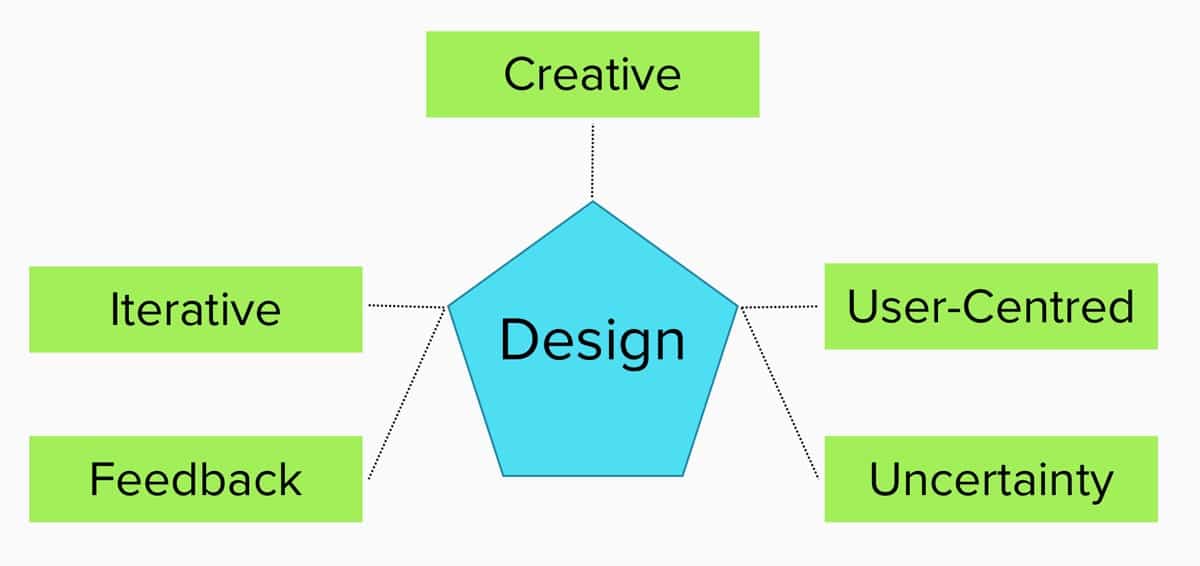
What is the Double Diamond?
The Design Council introduced the Double Diamond in 2004. It presents a framework that allows companies to apply design characteristics to find creative solutions and innovative ideas. It includes four steps: Discover, Define, Develop and Deliver. We will explore each step in this article later. Many companies adopted the Double Diamond design process, such as Apple, Microsoft, Starbucks and others. An updated version of the Double Diamond was introduced in 2019, which is agile and visualises how it can fit inside the organisation.
The double diamond is based on the frame innovation approach coined by Kees Dorst, Professor of Design Innovation at the University of Technology. In his approach, the design process can be divided into problem space and solution space. The problem space is when designers explore the problem, including its complex nature, and end with a clear definition of the problem. It is where the majority of the unique design characteristics and value lay, including creativity and uncertainty. The second stage is the solution space, where ideas are generated, visualised, and tested prototypes. At the end of this stage, the final product is created and delivered to the end user.
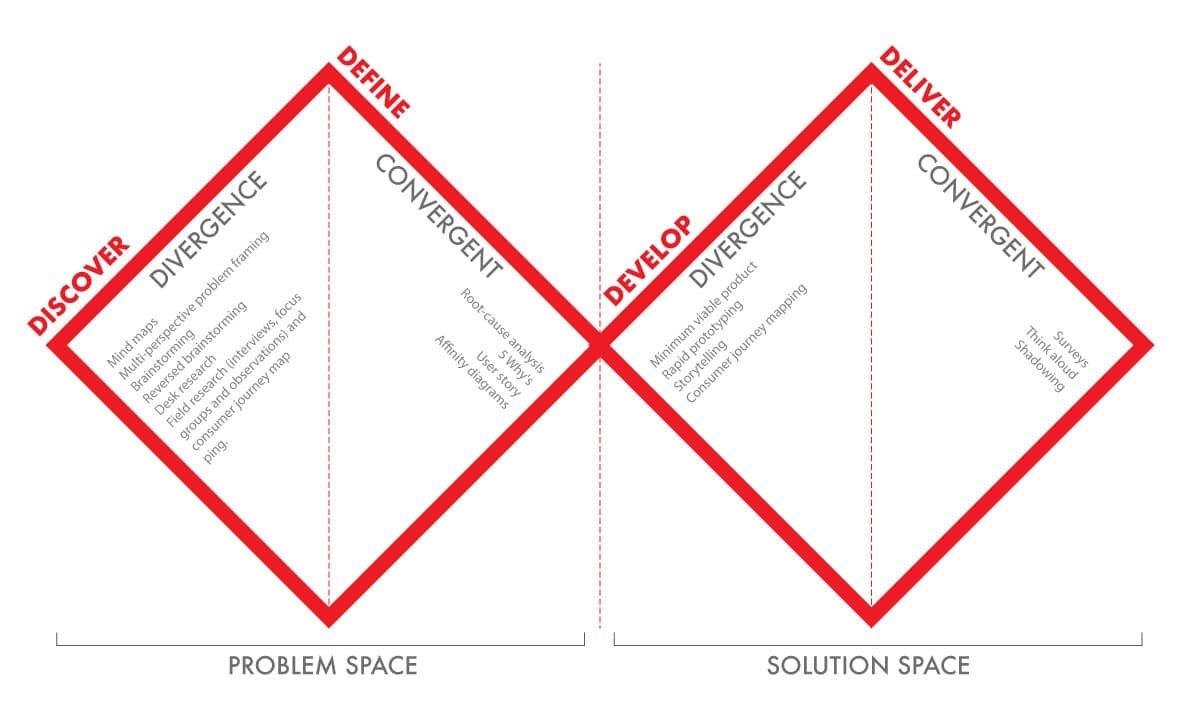
The frame innovation is applied to the Double Diamond framework as the first two steps (Discover and Define) present the first stage (problem space), and the third and fourth steps (Develop and Deliver) represent the second stage (solution space). We will explore the four steps of the Double Diamond design process as they remain unchanged between the 2004 and 2019 versions of the framework. Then we will overview the changes that were applied to the 2019 version.
As we explore the Double Diamond design process, we will briefly highlight some of the tools that could be used in each of the four steps. Some of these tools were covered in previous articles, while others will be covered in further articles.
Pre-Process Preparation
The Double Diamond design process is a highly collaborative team practice that requires complete understanding and integration between the team members. Accordingly, an effective selection of the team and place is essential. The team members should represent different areas where they are relevant to the project. Considering this factor ensures that the team members address different areas, especially in complex design projects.

In terms of the practice location, my experience is to run all the meetings in one place which is comfortable and has enough empty wall pace or target whiteboard is always beneficial because of two main reasons:
1- There will be many brainstorming drafts and sticky notes to visualise in front of the team through the process to keep in mind all the aspects of the design challenge at hand
2- Returning to the meeting room every morning and review the work done ensures the focus and continuity of the ideas as the team moves from one step to another.
Step 1: Discover
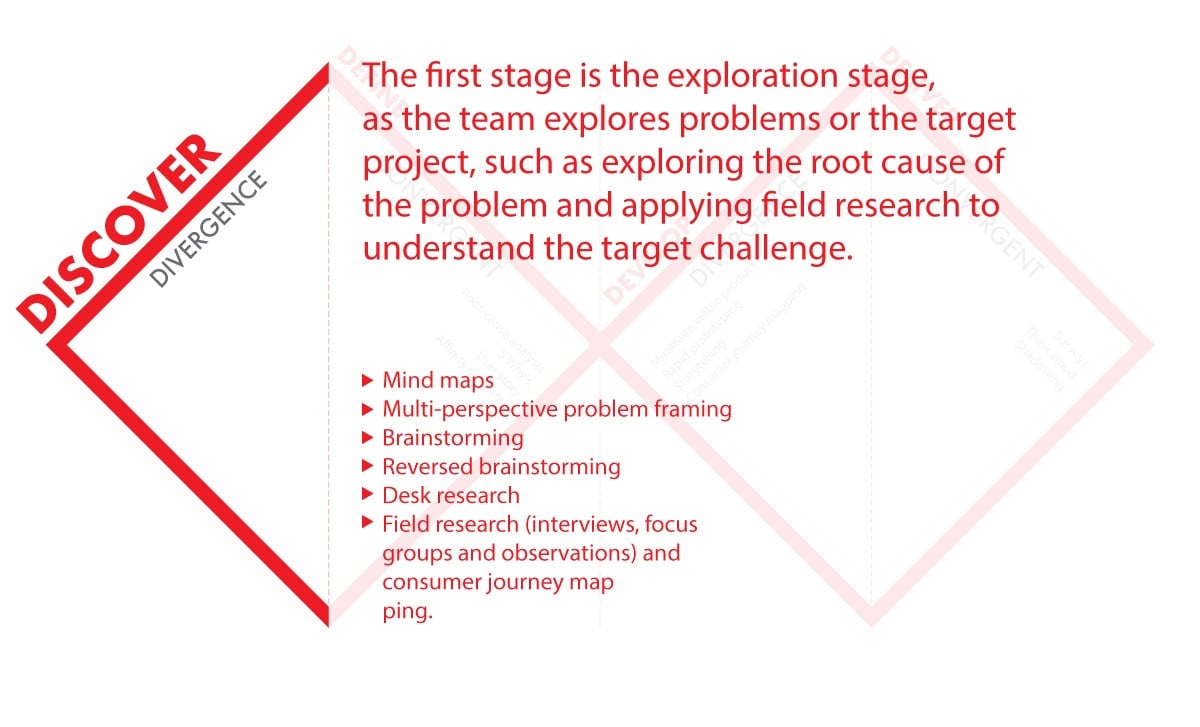
The first stage is the exploration stage, as the team explores problems or the target project, such as exploring the root cause of the problem and applying field research to understand the target challenge. The target of this step is to examine and collect information about the design challenge. The Discover step is divergent, which means that all ideas and information are considered and included. This step appreciates uncertainty as the team doesn’t have a clear idea about the problem, similar to the agile and lean processes. The support of creativity is applied based on the tools used to conduct this step. Examples of these tools are below:
Mind Maps: This tool is used to explore different ideas about a core problem. So, the main topic or issue is written in the centre and expanded and connected. The mind mapping can be drawn on paper, whiteboards or using online mind mapping tools.
Multi-Perspective Problem Framing (MPPF): The MPPF is coined by Dr Stuart English at the School of Design, Northumbria University. The method is based on the problem/solution framing aspect we explored earlier. The process is based on integrated mind maps where six cornerstones are explored to understand the problem. Click on the MPPF link above to access the published paper about the application of the method.
Brainstorming and Reversed Brainstorming: Brainstorming is a group meeting that aims to explore ideas based on group discussion and using different ideas. In contrast, the reversed brainstorming is used when the team feels out of ideas. In this tool, the team worsens the problem to shift the views toward opportunities that can ignite solutions.
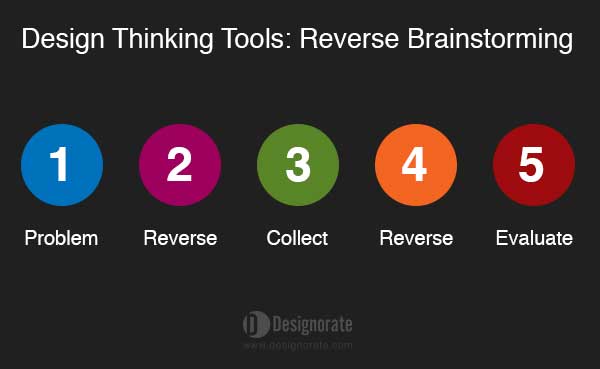
Desk research: The first step in exploring problems is to review the existing resources and publications about the topic to expand our knowledge.
Field research: The field research (primary research) has different methods that can be used to explore the problem, such as interviews, focus groups, and observation.
- Interviews: you can hold an online or face-to-face meeting with the target people involved in the problem investigated. It can be either structured, semi-structured or unstructured based on restricted with the questions. The semi-structured involves having pre-defined questions, but you can extend those questions based on the discussion with the person for more information.
- Focus groups: It is similar to interviews, but it is a group discussion rather than one-by-one. It can be cheaper and easier than the interviews. However, it has some drawbacks such as people can be influenced by each other ideas or sometimes being too shy to share their own.
- Observation: For me, this is the core of any design practice (or human practice). In this method, you can observe people in their lives, see how they interact with the problem, and document this in notes that will be analysed later.
Consumer Journey Mapping: In this method, the design team observes the user experience while using the product or the service. For example, the team can observe the user while making online booking tickets or shopping experience.
Step 2: Define
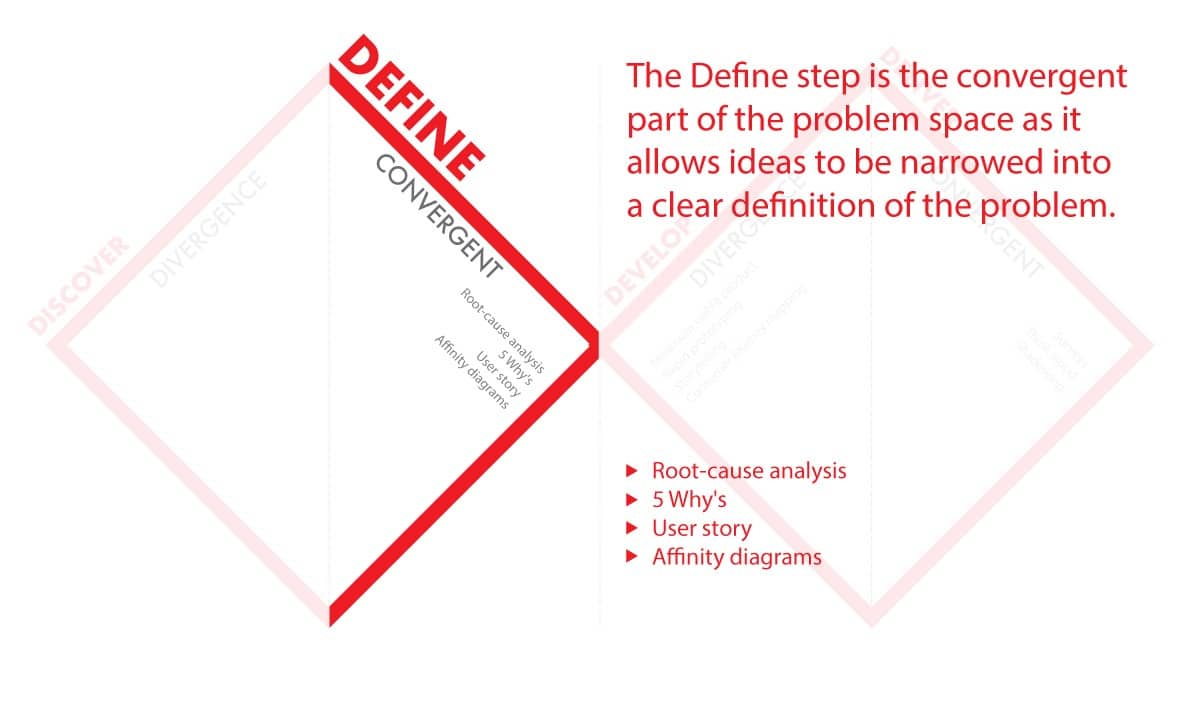
The Define step is the convergent part of the problem space as it allows ideas to be narrowed into a clear definition of the problem. This definition is the one that will lead the team into the following prototyping and testing steps. This convergent step involves analysing evidence and filtering ideas to reach a workable clear brief. The tools below are examples of tools that could be used in this step:
Root-cause analysis (AKA fish-bone analysis and Ishikawa diagram): After collecting sufficient information about the problems, you can analyse the data to understand the actual cause (root problem) to find a sustainable solution. The tool aims to investigate six main areas that can be the root cause of any problem (measurements, materials, personnel, environment, methods and machines).
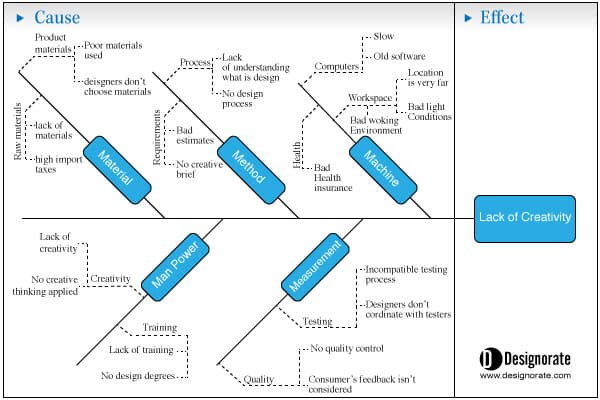
5 Whys: Another method for the root cause analysis is the 5 Whys. It simply asks “why” five times until you reach the root cause of the problem. Then, this root cause becomes the main cornerstone of the problem definition.
User story: This tool is commonly used in UX research as it reflects the type of the target user, the user’s practice and his or her final goal. An example of the user story can be:
As [description of the user], I want to [function] so that [benefit].
Affinity diagrams: The affinity diagram is a tool that works similar to Card Sorting. Furthermore, it allows you to organise the data and prioritise these data based on its importance. Then, you can set your problem description based on the data priority recorded.
Step 3: Develop
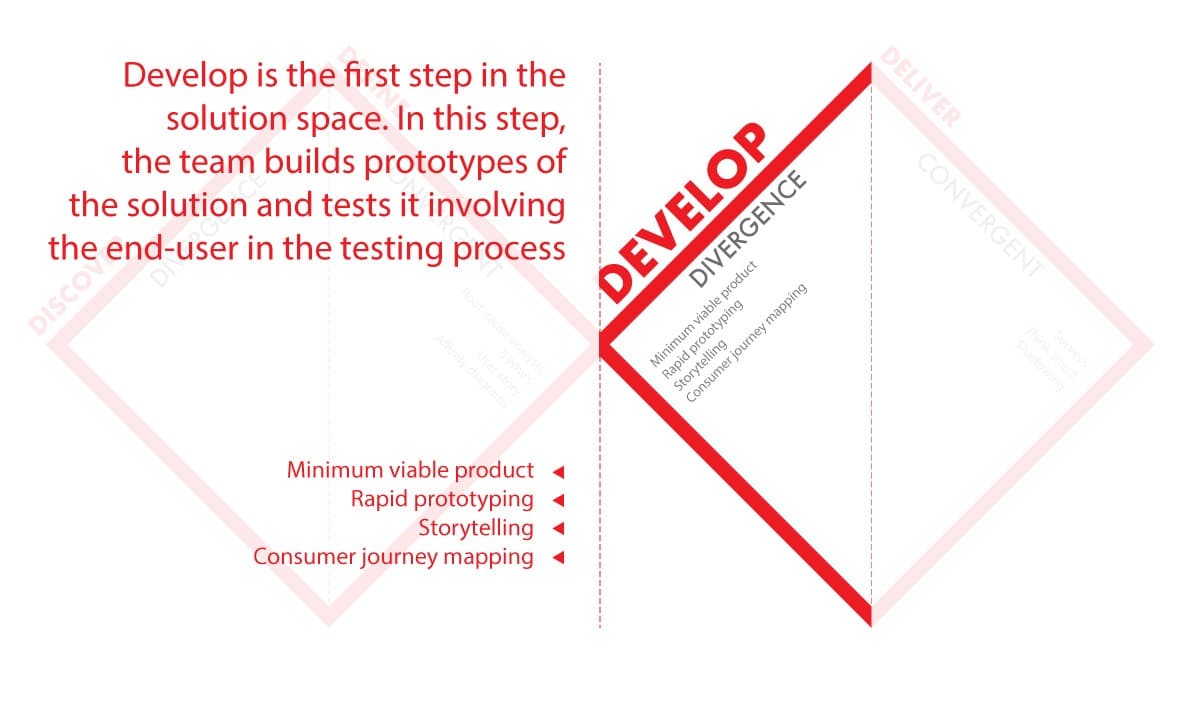
Develop is the first step in the solution space. In this step, the team builds prototypes of the solution and tests it involving the end-user in the testing process through a divergent approach, which means that all types of solutions as prototypes. First, the team need to clearly illustrate the target users by creating a persona for each target user. Persona is a virtual character representing the user and helps the design team consider the user’s characteristics during the prototype and development process. Several tools are used in this process:
Minimum Viable Product (MVP): The MVP is a limited version of the product with minimal features that make it workable, so users to test the product. Also, the team can evaluate the product or the service in a real-life scenario. Then, the team uses the feedback to improve the final complete product.
Rapid prototyping: Technologies such as 3D printing can create a sample of the product that allows the team to see a virtual example of the product and evaluate the product ideas.
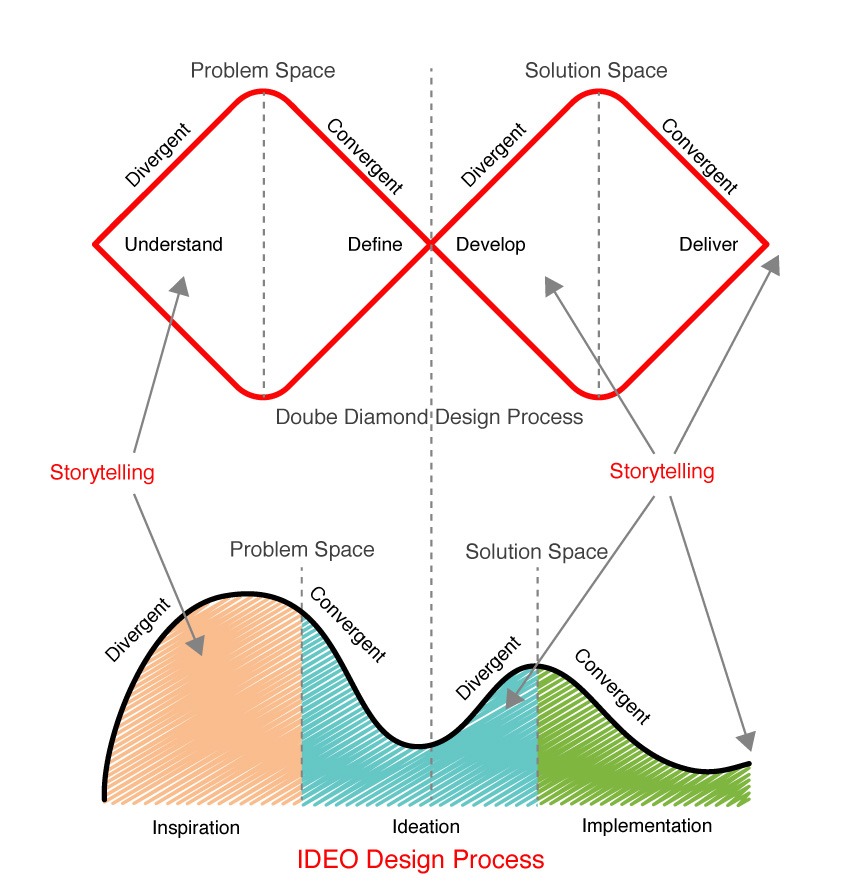
Storytelling: Storytelling can be used in both the Discover and the Develop steps. The storytelling allows the team to explore the prototypes and share their experience as a story.
Consumer Journey Mapping: Like the previous usage of the consumer journey mapping, the team can use it to test the service and evaluate it.
Step 4: Deliver
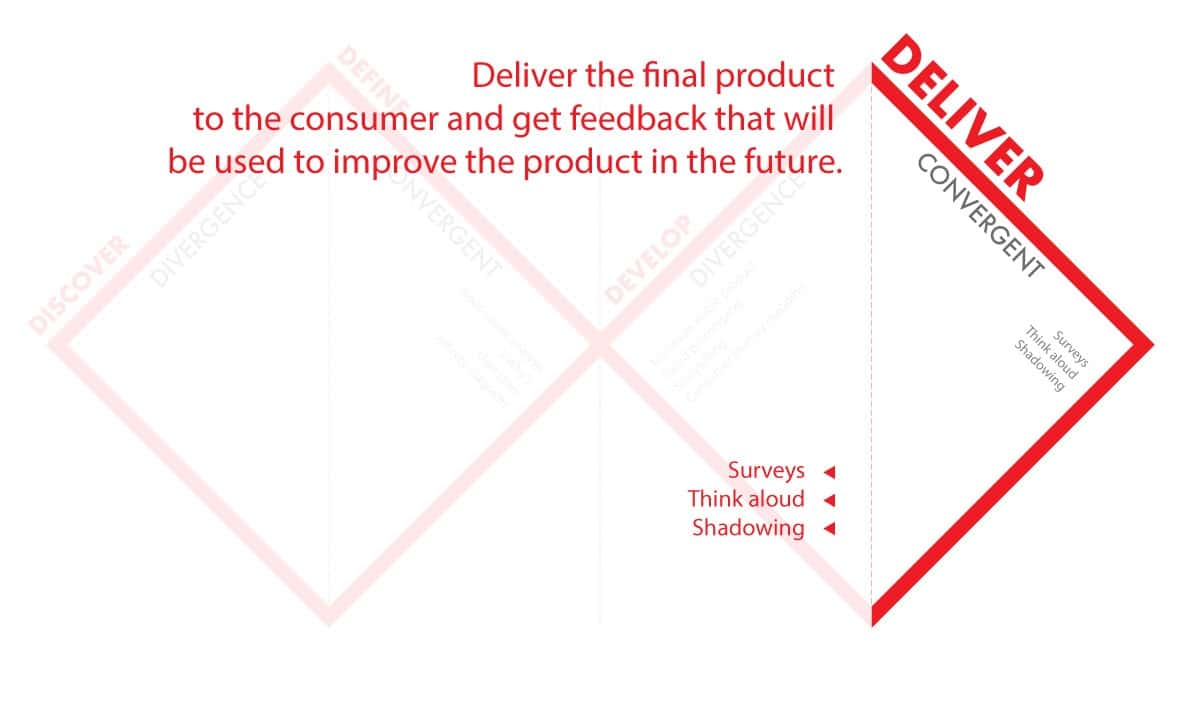
The relation between the designer the product doesn’t end here. Once the product is delivered, the team starts to collect user feedback and expertise evaluation. These commons and feedback are used to improve the future versions of the product. The Deliver is a conversion step where ideas are narrowed to one final product. Examples of the tools that could be used in this step include:
Surveys: They are the most common tool designers, and marketers use to get feedback through rating or simple questionnaires to collect details about the users’ comments and opinions about the product.
Think Aloud: In this tool, the consumer uses the product while describing the experience loudly. The designers take notes or recording of the consumer experience.
Shadowing: Another testing tool is where one design team follows the user (as a shadow) and takes notes as the user uses the product.
The New Double Diamond Design Process Framework
As a designer, the linear view of the design process is unrealistic, which applies to the Double Diamond or any linear design process. The design practice is non-linear, and how the ideas are formed, visualised and evaluated is not following a linear waterfall process. Sometimes, designers jump directly to the prototyping based on base requirements (lean process). This approach helps the designers to test the prototypes with the users and improve them through frequent user testing. Sometimes, the client has precise data that you jump directly to the third step (Develop). In the recent version of the Double Diamond (2019), the Design Council identified these issues and presented the updated Double Diamond framework.
The whole process starts with a challenge and ends with an outcome that runs in a collaborative environment that connects the team members, consumers, stakeholders, and partners and the leadership on the other side.
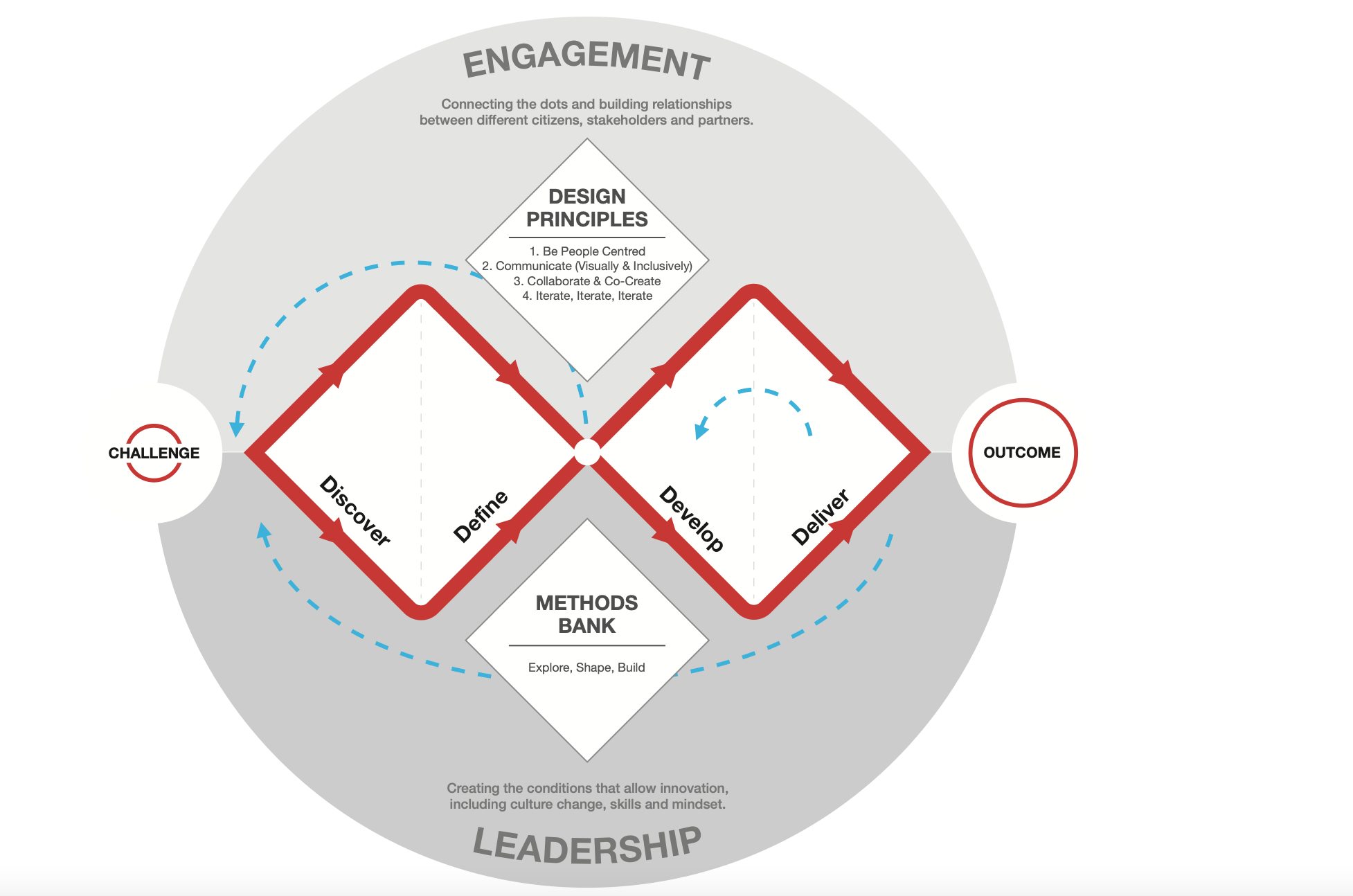
Figure 11 shows the updated version of the Double Diamond with adding an agile structure, which makes it more realistic comparing with the older version. In the new framework, the team can jump from the problem definition point back to the Discover step if they think more information needs to be explored or collected to build a clear definition of the problem. Also, they can jump back from the Deliver to the Develop if the product testing shows the need for other prototypes. Finally, The usage feedback from the consumers is forwarded to the Discover step to consider in future improvements of the product.
The below video shows a brief summary of what we explored in this article:
External Resources:
- Design Council’s framework for innovation
- The Double Diamond: A universally accepted depiction of the design process
How-to Summary
The below steps are a quick recap of what we explored earlier in more details.
How to Apply the Double Diamond Design Thinking process?
- Discover
Explore the problem with your team.
Tools: Mind maps, multi-perspective problem framing (MPPF), brainstorming and reversed brainstorming, desk research, field research (interviews, focus groups and observations) and consumer journey mapping. - Define
Clearly describe the problem need to be addressed.
Tools: Root-cause analysis, 5 why’s, user story, affinity diagrams - Develop
Create the solution prototype, test and iterate to improve the prototype.
Tools: Minimum viable product, rapid prototyping, storytelling and consumer journey mapping - Deliver
Deliver the final product to the consumer and get feedback that will be used to improve the product in the future.
Tools: Surveys, think aloud and shadowing
Conclusion
Any application of the design thinking process is aimless without a clear understanding of the design characteristics. The main aim of the process is to achieve these characteristics and use them to reflect a design strategy within the organisation. The Double Diamond design process, developed by the British Design Council, aims to achieve creativity and innovation through applying the design thinking methodology. It involves four steps (Discover, Define, Develop and Deliver) that take the design process from the problem space to the solution space. Above, we explore each step briefly and examples of the tools that could be used in them.
One of the drawbacks of the Double Diamond design process is its linear (waterfall) nature. This structure did not reflect the actual lean practice of the design process. So, a new version of the Double Diamond was introduced in 2019 with adding iterative features that turn it into an iterative lean process. Also, the new framework considers the nature of the organisation structure and puts the design characteristics at the heart of the process.


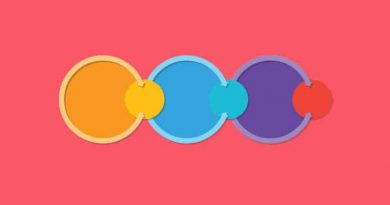




Thank you so much for your in-depth description, videos and clear images.
The videos help my students as well.
Dear Anne, I am glad that you find my article helpful. Also, I am fascinated that you teach the Double Diamond at your collage, feel free to share your experience teaching it for this age of students contact (@) rafiqelmansy (.) com